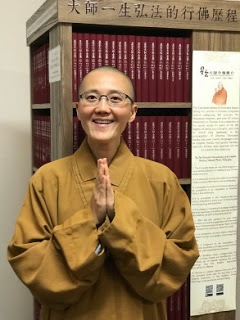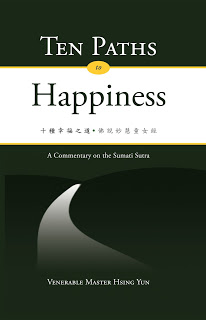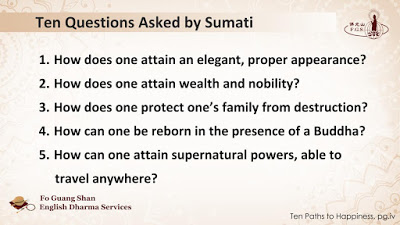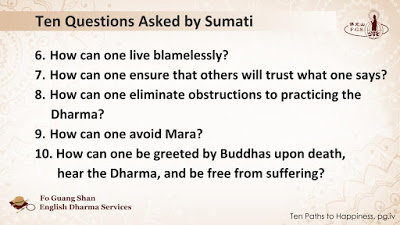
Speaker: Venerable Miaozang
FGS Hsi Fang Temple, San Diego
Auspicious greetings to all Dharma friends around the world. Thank you for tuning in to a new series of Fo Guang Shan English Dharma Services. My name is Miaozang, from Fo Guang Shan Hsi Fang Temple, San Diego, California. Today, I will share about the Ten Paths to Happiness from Sumati Sutra, the first of the coming six-part series. I will be making references from Venerable Master Hsing Yun’s book on the Ten Paths to Happiness. Now, join me in following the Buddha’s path in finding happiness.

I. Introduction
Sumati Sutra is part of a larger sutra called the Great Treasures Collection Sutra (Mahāratnakūṭa Sūtra), which describes the bodhisattva path. It was translated by Venerable Bodhiruci, from Northern India during the Tang Dynasty (703-716 A.D.). It took 13 years of combining new and old translations with 49 texts of varying lengths (equivalent to 120 fascicles).
This sutra is about Sumati, an 8-year old daughter of a famous Buddhist elder, who frequently attended the Buddha’s talks on Vulture Peak, Northeast of Rajagrha. She conducted herself with dignity and gentleness.

At one time, the Buddha was joined by an assembly of one thousand two hundred and fifty monastics, as well as ten thousand great bodhisattvas at Vulture Peak. Sumati calmly walked towards the Buddha. She bowed, circumambulated the Buddha three times, then knelt and joined her palms. She asked interesting questions in finding ways to happiness. The questions range from ways in having elegant and proper appearance, attaining wealth and nobility, maintaining harmony among ourselves, born in the presence of a Buddha, travelling freely, living blamelessly, being trustworthy, eliminating Dharma obstructions and avoiding maras.


Now, let us take a look at the first question on how one can attain an elegant, proper appearance.
II. The First Path to Happiness
In the sutra, the Buddha said,
“Sumati, bodhisattvas use four methods to attain elegant, proper form. What are the four?
- First, do not give rise to anger when dealing with unwholesome friends.
- Second, tranquilly abide with great loving-kindness.
- Third, take deep joy in the true Dharma.
- Fourth, make Buddha images.”
Let us look at the first point.
1) Do Not Give Rise to Anger
To many of us, anger is one of the ways to transfer feelings of guilt, fear, and hurt. When things are not going as we plan or as we wish, there might be hatred or agitation in our minds. When we are agitated, we might lose our sense of reasoning, putting aside our morals and losing our sense of humanity. Just like a Buddhist saying, “When one thought of anger arises, hundreds of thousands of obstacles are created.”
So, how do we not give rise to anger?
The Buddha shared this teaching in Majjhima Agama (MA25) in not giving rise to anger.
The Buddha said,
“If we are wise, when someone’s bodily actions are not kind but one’s words are kind, we should not pay attention to one’s unkind bodily actions, but only be attentive to one’s kind words…
“When someone’s words are not kind but whose bodily actions are kind. Do not pay attention to that one’s words. Only be attentive to one’s bodily actions…
“When we see someone whose bodily actions and words are not kind, but where there is still a little kindness in one’s heart, do not pay attention to one’s actions and words, but to the little kindness that is in one’s heart…
“When we see someone whose words and bodily actions are not kind, and in whose heart there is nothing that can be called kindness, give rise to this thought: ‘Someone whose words, bodily actions and whose heart is nothing that can be called kindness, is someone who is undergoing great suffering. Unless one meets a good spiritual friend, there will be no chance for one to transform and go to the realms of happiness.’
“Thinking like this, we will be able to open our hearts with love and compassion toward that person. We will be able to put an end to our anger and help that person.”
Thus, we should avoid looking for faults in those who do not treat us well or unkind in body, speech, or mind. We should look at the kindness that one has, whether it’s from the actions, words, or mind. If not, we should show kindness to those who do not have. When we have less anger, our appearance will be more gentle and dignified. Our lives will be more peaceful and harmonious.
2) Tranquilly Abide with Great Loving-Kindness
The second method that the Buddha shared is to tranquilly abide with great loving-kindness. Venerable Master Hsing Yun explains that loving-kindness means bringing sentient beings happiness whereas great loving-kindness means bringing happiness to sentient beings, whether they are relatives or strangers, far or near. It is an active method for healing the mind.
One example of great loving-kindness can be seen in the incident between the Buddha and Nalagiri, the great elephant.
One day, Devadatta, the Buddha’s cousin and a renounced monk who went sideways in his practice and tried to harm the Buddha. Knowing that the Buddha and sangha were going for alms round in the city near Bamboo Grove, he made Nalagiri drunk and opened the stable door.
Nalagiri was not cleared in its mind and went charging forward, breaking things along the road. Everyone was very scared as they saw the elephant approaching, swaying madly from one side of the road to the other, slamming his weight into market stalls and house-fronts. The Buddha’s attendant, Ananda, saw that and he placed himself before his teacher, trying to protect the Buddha.
The Buddha asked Ananda to step aside and then, the Buddha called up the force of loving-kindness from deep within himself, radiating his boundless heart toward Nalagiri.
The Buddha said, “Come, my friend.”

The elephant felt something brush against him like a cool wind. The Buddha radiated the oceanic power of loving-kindness toward Nalagiri. Nalagiri’s whole life began to unfold before it, recalling its days in the forest as a young calf, playing in rivers and lakes, wandering with its mother and aunt through groves of Sal trees. Then, it was captured by the king’s elephant-keepers and underwent to become a tusker and a slayer of men.
Nalagiri recalled the feelings of loneliness in the elephant stables, the fear, and pain. Like two waves meeting, the force of the Buddha’s loving-kindness collided with the moving mass of the raging elephant. Nalagiri felt it like a wave breaking against its brow, and its perception was cleared. It slowed down its charge to a walk. Nalagiri then saw the shimmering form of a monk in saffron robes. It lowered its head and paid respect to the Buddha. With great loving-kindness, the Buddha not only touched Nalagiri’s mind but also brought happiness to Nalagiri.
The great loving-kindness can be felt even without actions or words. This reminds me of another example of the great loving-kindness of the Buddha where sentient beings can feel it even through his shadow.
There was a time when the Buddha and Sariputra were walking and there were birds in the path. When the Buddha walked by, the birds remained calm and unmoved. However, when Sariputra walked closer, the birds flock away when his shadow shaded them. With this, we can tell that every beings can feel the Buddha’s compassion even with his shadow. Whenever I was walking on the road and there are birds or animals, I will always take this opportunity to see whether I have enough loving-kindness and compassion. I tried to walk softly and get closer to them. Of course, they will always fly away when I got closer and I know, there is still much practice I need to work on. If you are curious, you can try this too!
Loving-kindness and compassion are the foundation of the Buddha’s teachings. When we love others like ourselves and distill that into compassion for all sentient beings, this is unconditional great loving-kindness and compassion. When our mind is filled with great loving-kindness, our appearance will be compassionate, elegant, and dignified.
3) Take Deep Joy in True Dharma
The third method that the Buddha shared in attaining elegant, proper appearance is to take deep joy in true Dharma. Dharma has several different meanings. “Dharma” with a small “d” refers to all phenomena, whereas Dharma with a capital “D” refers to the Truth, the teachings of the Buddha. True Dharma refers to those teachings which are right, correct, and do not deviate from the Middle Way.
How can we find true joy in Dharma?
The Dharma that the Buddha shared with us allows us to better understand life and to see the improvements when we practice righteousness in our daily living. The Dharma joy will arise from when we experience happiness and satisfaction. However, in today’s society, many people say they know they should rejoice in the true Dharma, but in reality, they embrace false Dharma all the time and enjoy listening to false teachings, especially those that emphasize on supernatural power and instant enlightenment. These false teachings might seem tempting to many but these will lure one into more greediness and being unclear of the Buddha’s Teachings. Thus, we should be aware and mindful of what we practice.
One of the main practice is the “Noble Eightfold Path,” a code of moral conduct we cultivate with the main focus on relieving suffering. When we practice the Dharma at home, at work, at the temple, or wherever we are, our bodily actions, speech, and mind will be of righteous and wholesome. We will experience the difference and improvements.
I remember when I was still at Fo Guang Shan Buddhist college in Dong Zen Temple, Malaysia, every day we would have chores time. For two months, I was assigned to the group that is responsible for sweeping the floor. As the area that I swept was about the size of five classrooms. By the end of the first day, I already had blisters on my hands. I then tried out different ways in sweeping and holding the broom. Eventually, I found out that by sweeping them into many piles on different locations were easier and saved me more energy and time. Everyday eventhough I was sweating and so tired after sweeping, seeing the cleanliness of the floor, my mind was filled with Dharma joy. Just like Cudapindaka, the disciple of the Buddha, who recited this “sweep away the dust and remove the dirt” when sweeping the ground and realized that the inner three poisons of greed, hatred, and ignorance can only be purified with the Dharma. If we can delight in the true Dharma, we can have satisfying lives for ourselves. When our mind is at ease and peace, this will show in our appearances.
4) Make Buddha Images in this Very Mind
The fourth method shared by the Buddha is to make Buddha images in this very mind. Why should we make Buddha images? Did the Buddha really want everyone to make images of him and worship his body? This is actually a skillful means for us to remember our teacher, the Buddha, and reminding ourselves of the potential we have within our mind in realizing Buddhahood.
So, what will happen if our mind has the image of the Buddha? When we venerate the Buddha images, it strengthens our faith and helps us persevere in our practice. Whenever we are about to get angry and we saw the Buddha’s image, we will remind ourselves of the Buddha, asking what will the Buddha do in facing a similar situation? Whenever we have unwholesome thoughts in our mind, the Buddha images will remind us not to do so. Without an image or symbol to venerate, how will people find a worthy figure to model themselves after? Thus, the Buddha image is a means by which we can connect with the Buddha’s mind, helping us to discover the Buddha nature within ourselves. Then, the mind gradually becomes free of illusory thoughts. Amid formlessness, our temperament changes. After that change, we will gradually develop an elegant, proper appearance as well.
III. Conclusion
To end today’s session on the first question about how proper form attained, the Buddha guides us with the four points: do not give rise to anger when dealing with unwholesome friends, tranquilly abide in great loving-kindness, take deep joy in true Dharma and make Buddha images. Always remember, anger ruins virtuous roots; we must not allow them to grow. Entrust our body and mind to great loving-kindness and compassion. Love the Dharma, practice the Dharma, and protect the Dharma. Create the Buddha’s images so that others can venerate them. Then, one will obtain an elegant, proper appearance, which all sentient beings will delight in seeing and to be with.
Next week, we will be discussing the second and third paths to happiness on how to have perfect wealth and maintaining harmony in our society.
Let us conclude this lecture by joining our palms, and dedicating the merits of this session to our family, friends, society, and all beings. Last but not least, thank you for joining us in today’s session. If you find this lecture series helpful to your practice, please subscribe to the FGS English Dharma Services Youtube Channel and share it with your friends. See you next week. Omituofo.
Ten Paths to Happiness: A Commentary of the Sumati Sutra

By: Venerable Master Hsing Yun
Published by: Buddha’s Light Publications
We all want to be happy. Twenty-six hundred years ago a young girl named Sumati asked the Buddha ten earnest questions on how to live happily in this life and beyond, with the Buddha’s detailed responses revealing that happiness can only be attained when we understand the nature of the world and practice for the benefit of others. In Ten Paths to Happiness, Venerable master Hsing Yun explicates these precious teachings and presents the path to lasting happiness to all who wish for peace, harmony, equality, and liberation from suffering in this life.
Click here for more information.

